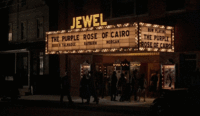- html - 出于某种原因,IE8 对我的 Sass 文件中继承的 html5 CSS 不友好?
- JMeter 在响应断言中使用 span 标签的问题
- html - 在 :hover and :active? 上具有不同效果的 CSS 动画
- html - 相对于居中的 html 内容固定的 CSS 重复背景?
我在调整电影图像的大小时遇到问题。如果您不知道,它们是仅对图像的一部分进行动画处理的 gif,与对整个图像进行动画处理的常规 gif 相比。这是一个 node.js 示例:
// ![http://i.imgur.com/Qb1m0.gif][1]
var gm = require('gm')
var file = 'Qb1m0.gif',
frags = file.split('.')
gm(file)
//.noProfile()
//.quality(80)
.resize(200, 200)
.write(frags[0] + '_200.' + frags[1], function(err) {
if (err) console.error(err)
})
// Result:
// ![http://i.imgur.com/eFqak.gif][2]
gm convert Qb1m0.gif -resize 200x200 cinema_200.gif


最佳答案
我确实比 GraphicsMagick 更了解 ImageMagick。对于 ImageMagick,以下声明适用:
identify 查看原始 GIF ,您会看到并非每个框架都具有相同的尺寸:
identify Qb1m0.gif Qb1m0.gif[1] GIF 720x416 720x416+0+0 8-bit PseudoClass 256c 920KB 0.000u 0:00.009 Qb1m0.gif[1] GIF 471x122 720x416+160+75 8-bit PseudoClass 256c 920KB 0.000u 0:00.009 Qb1m0.gif[2] GIF 471x121 720x416+160+76 8-bit PseudoClass 256c 920KB 0.000u 0:00.009 Qb1m0.gif[3] GIF 471x123 720x416+160+75 8-bit PseudoClass 256c 920KB 0.000u 0:00.009 Qb1m0.gif[4] GIF 471x123 720x416+160+75 8-bit PseudoClass 256c 920KB 0.000u 0:00.009 Qb1m0.gif[5] GIF 471x123 720x416+160+75 8-bit PseudoClass 256c 920KB 0.000u 0:00.009 Qb1m0.gif[6] GIF 471x123 720x416+160+75 8-bit PseudoClass 256c 920KB 0.000u 0:00.009 Qb1m0.gif[7] GIF 471x123 720x416+160+75 8-bit PseudoClass 256c 920KB 0.000u 0:00.009 Qb1m0.gif[8] GIF 471x122 720x416+160+76 8-bit PseudoClass 256c 920KB 0.000u 0:00.009 Qb1m0.gif[9] GIF 471x123 720x416+160+75 8-bit PseudoClass 256c 920KB 0.000u 0:00.009 Qb1m0.gif[10] GIF 471x123 720x416+160+75 8-bit PseudoClass 256c 920KB 0.000u 0:00.000 Qb1m0.gif[11] GIF 471x123 720x416+160+75 8-bit PseudoClass 256c 920KB 0.000u 0:00.000 Qb1m0.gif[12] GIF 471x123 720x416+160+75 8-bit PseudoClass 256c 920KB 0.000u 0:00.000 Qb1m0.gif[13] GIF 471x122 720x416+160+76 8-bit PseudoClass 256c 920KB 0.000u 0:00.000 Qb1m0.gif[14] GIF 471x123 720x416+160+75 8-bit PseudoClass 256c 920KB 0.000u 0:00.000 Qb1m0.gif[15] GIF 471x123 720x416+160+75 8-bit PseudoClass 256c 920KB 0.000u 0:00.000
These variations in the dimensions are the result of frame optimizing the animated GIF has been subjected to in order to reduce file size.
There are other optimizations at play too, which do reduce the number of colors used. Both these types of optimizations don't combine well with the -resize operation.
-resize is designed for single images, and to make the resulting single image look as good as possible. This very often adds new color values to the image. This does contradict what GIF is designed for: using a strictly limited color table (maximum of 256 colors). In an animation sequence, the next image/frame's -resize may result in a completely different color table than the previous one produced -- but for a well working animation you'd need a common color table across all frames.
-resize handles each and every frame image totally separately from the other images and does not take into account 'frame optimizations' (which have the tendency to create a different width+height for each frame that's placed on the common canvas with its own offset).
Thus the resized images are far from ideal for saving to the limited GIF file format for single images, let alone for multiple frames of an animated GIF. Heavy color reductions in the resized images are the result.
Then there is the transparency problem: most animated GIFs do make heavy use of transparency. Transparency is frequently used to even achieve compression optimizations where normally the image's appearance wouldn't require transparency at all.
What happens in this case is this: -resize creates semi-transparent pixels in the overlay images. When the images are saved back to the GIF file format, these pixels are then converted to either full transparency or full opacity: both produce a heavy color distortion for the resulting animation, away from the original color.
Generally the best procedure to resize animated GIFs is this:
Coalesce (de-optimize) the animation. This will create individual images of equal size for all frames of the animation.
Undergo a complete GIF optimization sequence for the animation: not just for frame optimization, but also for color optimization.
To still try your luck with running a 'simple' resize command, you could try this:
convert \
http://i.imgur.com/Qb1m0.gif \
-coalesce \
-resize 200x200 \
cinema_200.gif

-resize 生成的半透明颜色。运算符(operator)。
关于image - 调整电影图像(动画 GIF)大小时的问题,我们在Stack Overflow上找到一个类似的问题: https://stackoverflow.com/questions/12293832/
问题是什么? 我在 Pythonanywhere.com 上运行 This error can be due to the fact that ImageMagick is not installed
我目前正在设计一个电影数据库。我目前有一个包含电影标题、长度等的电影表。然后我有一个类型转换。我在这些之间有一个与 filmid 和 actorid 之间的联结表。这将包含在影片中扮演角色的所有 Ac
所以,我有一个包含 3 个表和相关列的数据库: 标签:TID、标签名称 电影:MID、movie_title tags_to_movies:电影 ID、标签 ID 如何选择至少具有我想要的标签的电影。
我的程序在 GNUPlot 中生成了 100 个图。我想将它们连接成一部短片,其中每个情节约为 0.1 秒。我怎样才能最有效地做到这一点? 我能想到的效率最低的方法是拍摄每个情节的屏幕截图,以某种方式
我正在使用 ffmpeg 剪切视频文件: ffmpeg - -ss 00:00:00 -t 00:00:30 不包括 *.avi 格式的不同文件格式是可以的。对于 avi 电影,ffmpeg 显示视
关闭。这个问题不满足Stack Overflow guidelines .它目前不接受答案。 想改善这个问题吗?更新问题,使其成为 on-topic对于堆栈溢出。 4年前关闭。 Improve thi
是否有任何方法可以模拟视频应用程序,以便我们仍然保持对设备(iPad/iPhone)的控制,但通过电缆将视频发送到电视?我研究了屏幕镜像,但它对于视频来说太慢了,而且无论如何,Apple 不再允许屏幕
关闭。这个问题不符合Stack Overflow guidelines .它目前不接受答案。 我们不允许提问寻求书籍、工具、软件库等的推荐。您可以编辑问题,以便用事实和引用来回答。 关闭 7 年前。
我正在开发 Windows 服务,我的 Windows 服务使用“ffmpeg”,同时我正在开发用于测试代码的桌面应用程序。 我想在我的视频中导入水印。我可以用我的桌面应用程序做到这一点。但是当我运行
就目前而言,这个问题不适合我们的问答形式。我们希望答案得到事实、引用或专业知识的支持,但这个问题可能会引起辩论、争论、投票或扩展讨论。如果您觉得这个问题可以改进并可能重新打开,visit the he
我正在编写一个Mac应用程序,可以将不同来源的视频下载到本地硬盘。到目前为止效果很好,但我想允许用户在下载这些视频时播放这些视频。浏览 QTKit 的文档,我找不到任何方法可以让我将电影数据分段提供给
我已经尝试通过另一个用户的建议,使用嵌入 Flash 的 swfobject 方法。然而,我一定没有那么聪明。 下面是我想出的怪物,但没有电影播放,当我控制+单击(Mac)时,我什至无法将它区分为 F
已关闭。此问题旨在寻求有关书籍、工具、软件库等的建议。它不符合 Stack Overflow guidelines 。它目前不接受答案。 我们不允许提问寻求书籍、工具、软件库等的推荐。您可以编辑问题
我注意到 GIF 并不是真正兼容所有浏览器,所以我一直在使用电影。直到现在一直在寻找。我有一个带有用 css 编写的背景图片的网站。我觉得这行不通,但我尝试像链接图像一样链接电影,但它甚至没有出现。下
有人知道是否有可能(在 PHP 中)从服务器上的 quicktime 电影中获取帧/缩略图吗? 类似于通常的 GD 缩略图生成,但用于 .mov 文件。 注意:我使用的是 dreamhost,所以我只
我需要根据一系列生成的图像制作一部电影。 (我正在根据物理建模程序的输出创建图像。) 我在 QtKitCreateMovie 中找到了 Apple 的示例,并将其用作起点。我没有从应用程序包中加载 j
我想创建具有 2 个 View 的非常简单的应用程序:-> 列出一些标签-> 带电影的单 View 每个标签都连接到一个 flash 电影。这部电影将在我自己的网络服务器上。我想在我的应用程序中与一些
将 JSON 传入和传出 Flash 电影的最佳方式是什么? 目前在 javascript 和 Flash 之间进行通信: 我正在使用“flashvars”在最初加载时将数据传递给 Flash 电影
我正在开发一个 chromecast 发送器应用程序,我希望在其中启动 Netflix 并播放请求的电影。但是,我只能设法启动 Netflix 应用程序,但它不会加载视频,因为我不确定需要随请求发送哪
因此,当我尝试访问我的应用程序上的电影页面时出现以下错误: ActionController::ParameterMissing (param is missing or the value is e

我是一名优秀的程序员,十分优秀!